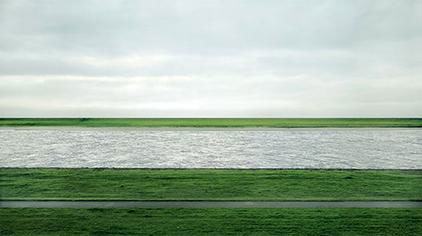
The Rhine &”Stripes of Green and Gray”
The Rhine is frequently assumed of as the inspiration for the world’s good fairy tales and poetry – but “Rhine romanticism” swept the art entire world at the close of the 18th century many thanks to the legendary riverscapes and web-sites together the breadth of the river. The Rhine is extremely photogenic (as found higher than in a visitor image taken on a Tauck Rhine river cruise) – and is as very well recognised as the inspiration for photography and prints as artwork, as you’ll discover with the tale of “Stripes of Green and Gray.”
 In 2011, Andreas Gursky’s image Rhein II (at right) was bought for $4,338,500 at a Christie’s auction – breaking the document for the most costly photograph at any time marketed at auction. The German photographer is renowned in the photography entire world, and has pics on display screen from London’s Tate Contemporary to the Museum of Artwork in New York Town. He has offered other photos at auction for considerable sums – but this photo, and this quantity, broke the file for the most pricey photograph ever sold at auction.
In 2011, Andreas Gursky’s image Rhein II (at right) was bought for $4,338,500 at a Christie’s auction – breaking the document for the most costly photograph at any time marketed at auction. The German photographer is renowned in the photography entire world, and has pics on display screen from London’s Tate Contemporary to the Museum of Artwork in New York Town. He has offered other photos at auction for considerable sums – but this photo, and this quantity, broke the file for the most pricey photograph ever sold at auction.
Francis Outred, who was the head of Europe in post-war and present-day artwork at Christie’s, informed NPR: “The Rhine is ‘one of the most symbolic motifs in German art it runs as a result of Andreas Gursky’s hometown of Dusseldorf, as properly as 6 European countries, and has motivated art for hundreds of years. This photo is fantastic: “One of the most potent and profound depictions at any time to be made of the Rhine, the photo’s unique scale attracts an ineffable connection to the true all-natural landscape, inviting the viewer to cross around into its vivid photo plane.”
The photo actions 6 x 11 toes and symbolizes Gursky’s unique system of combining movie and electronic processes. According to the Tate, “The Rhine II was created in an version of six Tate owns the fifth in the series. This substantial colour photograph depicts a stretch of the river Rhine outside the house Düsseldorf. The graphic is right away legible as a check out of a straight stretch of drinking water, but it is also an abstract configuration of horizontal bands of color of varying widths. The horizon line bisects the image pretty much precisely in the center. Above it the overcast sky is a blue-grey. In the base 50 % of the impression, the river is a glassy, unbroken band between environmentally friendly stripes of grass. At the base of the photo in the instant foreground is a slender path. Down below it is another slim band of manicured green grass.”
“Gursky will work with a medium structure camera, taking pics which he then scans into a laptop wherever he can manipulate them. His purpose in working with electronic technology is not to make fictions but instead to heighten the image of one thing that exists in the planet. He has explained the genesis of this get the job done, indicating, ‘there is a specific area with a perspective in excess of the Rhine which has by some means often fascinated me, but it didn’t suffice for a photo as it mainly constituted only part of a photo. I carried this strategy for a picture around with me for a calendar year and a fifty percent and believed about whether or not I should potentially to modify my viewpoint … In the end I made a decision to digitalise the images and leave out the features that bothered me.’ Gursky digitally erased properties on the much facet of the river from his photograph. Gursky’s photograph is a detached comment on the elegant connotations of Romanticism.”
And however to most onlookers, as described by several critics and publications, the prized Rhine image is summed up merely as “stripes of environmentally friendly and gray”…
Consider a seem down below at some interesting documentaries profiling not only Andreas Gursky, but other art and artists encouraged by the Rhine and rivers of Europe:
Exploring…
